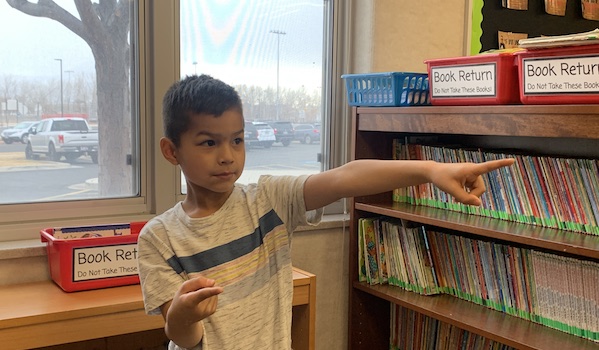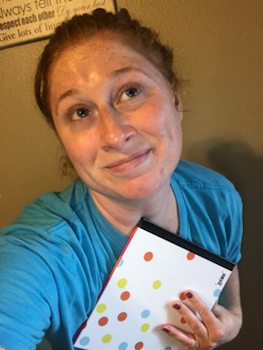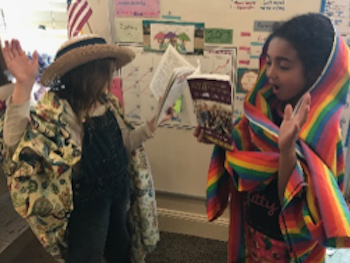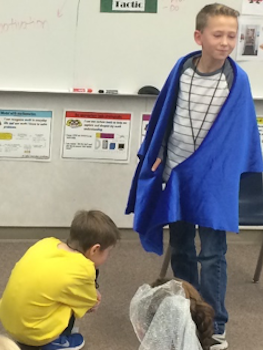SUBJECTS
GRADE
Show Results
Is This on Sale? Everyday Math Applications

Lesson Summary
- Perform a scripted two-person scene featuring an everyday exchange.
- Rewrite the script to emphasize the application of everyday math skills.
Lesson Plan and Procedure
Lesson Key Facts
- Grade(s): 4, 5, 6
- Subject(s): Drama, English Language Arts, Math
- Duration of lesson: 55 minutes
- Author(s): Haley Flanders Anderson
Warm-Up/Hook
Begin the lesson by having students stand in a circle, then introduce the game “Pass the Book.”
 Teacher: We are going to play two different rounds of “Pass the Book.” This is just a regular book. Don’t worry about what the book is called or what it is about. We are going to pass this book around the circle. Once you receive the book, I want you to react some way to it. DO NOT use words. Instead, use your face, body, and sounds. Interact with it. Perhaps the book is wonderful, smelly, boring, heavy, scary, weird, intriguing, loud, possessed, or something else. Then pass the book to the person next to you. Try not to copy anyone else.
Teacher: We are going to play two different rounds of “Pass the Book.” This is just a regular book. Don’t worry about what the book is called or what it is about. We are going to pass this book around the circle. Once you receive the book, I want you to react some way to it. DO NOT use words. Instead, use your face, body, and sounds. Interact with it. Perhaps the book is wonderful, smelly, boring, heavy, scary, weird, intriguing, loud, possessed, or something else. Then pass the book to the person next to you. Try not to copy anyone else.
Start off the round by reacting to the book and passing it to the left or right. Once the book returns, begin the second round.
Teacher: Now for the second round, I want you to use words while you animate your face and body. Interact with the book in a way that is mathematical. Use numbers and everyday calculations to describe the book. Perhaps you can hold the book and announce its weight, its height, its length, its number of pages, its age, its price, the time it took to be written, and so on. You are just making it up, so do not worry about accuracy.
Start off the round by reacting to the book mathematically (e.g., “This book weighs two pounds, six ounces”). Once the book returns, have the class members give each other a round of applause.
Reflection
Teacher: Which round of “Pass the Book” did you like better? Why? What was challenging about either round? You all discovered many ways to describe or respond to a book, both emotionally and mathematically. A book is just an everyday object. And in our activity today, you and your partner will receive a simple script of an everyday interaction. Then you will rewrite it so that you are responding to it more mathematically.
Introduction
Teacher: There are seven scenes. Each takes place in a different location and involves very simple, normal conversation. Here are the titles:
- “At the Shoe Store”
- “At the Post Office”
- “At the Movie Theater”
- “Shopping for Clothes”
- “At a Restaurant”
- “At the Crosswalk”
- “On an Airplane”
Instruction/Rehearsal
Hold up one of the papers.
 Teacher: Every scene involves two people (except for “On an Airplane,” which involves three, in case we have an uneven number of students). Each paper has two copies of the script. The top version is to be left blank. You will perform this one as written. The bottom one is for you and your partner to change. You can cross out and add words and sentences, but do not add new characters or change the location. Your goal is to change the bottom script so that it heavily involves the use of everyday math. Consider the math we have been studying in class lately. You can include dialogue about money, weight, volume, geometry, distance, height, time, temperature, and whatever else involves mathematical concepts. Have the dialogue be the active solving of a math problem. Many scenes already include numbers. Use that as a starting point, but make it more complex, as if the characters are incredible mathematicians. Then you will perform the scene.
Teacher: Every scene involves two people (except for “On an Airplane,” which involves three, in case we have an uneven number of students). Each paper has two copies of the script. The top version is to be left blank. You will perform this one as written. The bottom one is for you and your partner to change. You can cross out and add words and sentences, but do not add new characters or change the location. Your goal is to change the bottom script so that it heavily involves the use of everyday math. Consider the math we have been studying in class lately. You can include dialogue about money, weight, volume, geometry, distance, height, time, temperature, and whatever else involves mathematical concepts. Have the dialogue be the active solving of a math problem. Many scenes already include numbers. Use that as a starting point, but make it more complex, as if the characters are incredible mathematicians. Then you will perform the scene.
Split the class into groups of two, with one group of three if needed (use scene “On an Airplane” for the group of three). Hand out a different scene to each group. Depending on class size, the same scene may be performed by more than one group. Make sure every student has his or her own double copy of the scene. Give them time to rewrite and rehearse.
Teacher: As you rewrite, make sure the scene still has a strong story structure with a beginning, middle, end, clear characters, and answers to the six storytelling questions (who, what, when, where, why, and how). Also, remember to include enough mathematical dialogue so that a complex math problem is solved. Lastly, this is a performance, so consider how to use your voice, face, and body to animate your characters, just like round one of “Pass the Book.”
Activity/Performance
Gather the students back up, and have them perform their two scenes for the class: first, they’ll perform the scene as it was originally written, and then they’ll perform the scene after it was rewritten into a mathematical problem. Have the students perform the scenes, in order, from numbers one to seven. If you have more than one group performing the same scene, decide who goes first. As groups perform, encourage the other groups to prepare feedback for after everyone has performed.
Conclusion
 Teacher: What did you like about this activity? Why? What was challenging about it? Other than your group, which group’s rewrite did you like the best, and why? What do these scenes of everyday interactions in various locations teach us about the importance of math? For a follow-up, on a blank sheet of paper, write down your rewritten mathematical scene as a word problem. Include the answer on the back. We will turn these in and make a class book of word problems.
Teacher: What did you like about this activity? Why? What was challenging about it? Other than your group, which group’s rewrite did you like the best, and why? What do these scenes of everyday interactions in various locations teach us about the importance of math? For a follow-up, on a blank sheet of paper, write down your rewritten mathematical scene as a word problem. Include the answer on the back. We will turn these in and make a class book of word problems.
Extension Activity
If your students enjoyed performing scripted partner scenes, consider having them perform scenes from the book Acting Scenes and Monologues for Kids by Bo Kane. They contain short, relatable, hilarious everyday situations for kids.
Learning Objectives
- Establish a situation and characters who respond to actions.
- Use descriptions and concrete words.
- Analyze multiple accounts of a topic, comparing and contrasting.
- Adapt speech to a variety of contexts and tasks.
- Represent real-world and mathematical problems.
- Convert among different-sized standard measurement.
- Develop imagination and use it to support choices.
- Demonstrate audience skills and accept feedback.
- Create characters with gesture and voice.
Utah State Board of Education Standards
This lesson can be used to meet standards in many grades and subject areas. We will highlight one grade's standards to give an example of application.
Grade 5 English Language Arts
Standard 5.R.11: Analyze multiple accounts of the same event or topic, noting important similarities and differences in the point of view they represent. (RI)
Standard 5.R.4: Read grade-level text* with accuracy and fluency to support comprehension. (RL & RI)
Standard 5.W.3: Write narrative pieces to develop real or imagined experiences or events using effective technique, descriptive details, well-structured event sequences, and provide a resolution.
Grade 5 Mathematics
Standard 5.MP.2: Reason abstractly and quantitatively. Make sense of quantities and their relationships in problem situations. Contextualize quantities and operations by using images or stories. Decontextualize a given situation and represent it symbolically. Interpret symbols as having meaning, not just as directions to carry out a procedure. Know and flexibly use different properties of operations, numbers, and geometric objects.
Standard 5.MP.4: Model with mathematics. Identify the mathematical elements of a situation and create a mathematical model that shows the relationships among them. Identify important quantities in a contextual situation, use mathematical models to show the relationships of those quantities, analyze the relationships, and draw conclusions. Models may be verbal, contextual, visual, symbolic, or physical.
Standard 5.MD.1: Convert among different-sized standard measurement units within a given measurement system (for example, convert 5 cm to 0.05 m); use these conversions in solving multi-step, real-world problems.
Standard 5.MD.3: Recognize volume as an attribute of solid figures and understand concepts of volume measurement.
Standard 5.G.3: Understand that attributes belonging to a category of two-dimensional figures also belong to all subcategories of that category. For example, all rectangles have four right angles and all squares are rectangles, so all squares have four right angles.
Grade 5 Drama
Standard 5.T.CR.1: Develop imagination to create artistic ideas and work.
Standard 5.T.CR.2: Arrange the physical playing space to communicate mood, time, and locale.
Standard 5.T.CR.3: Write or record simple dramas that include the five Ws of who, what, where, when, and why.
Standard 5.T.CR.4: Define roles, identify responsibilities, and participate in group decision making.
Standard 5.T.P.1: Analyze the character, setting, and essential events (plot) in a story that make up the dramatic structure and use choices to enhance the story in a drama/theatre work.
Standard 5.T.P.4: Communicate meaning using the body through space, shape, energy, and gesture.
Standard 5.T.R.1: Demonstrate audience skills of observing attentively and responding appropriately.
Standard 5.T.R.4: Give and accept constructive and supportive feedback; analyze and describe strengths and weaknesses of own work.
Equipment and Materials Needed
- A book
- Pencils
- Blank paper (for follow-up)
- “Everyday Math Application Scenes” PDF (includes all seven scenes)
- If using “On An Airplane,” print it on both sides of the paper, since each student needs two copies of the scene. This way, each student only has one piece of paper.
Additional Resources
- Link to purchase the book Acting Scenes and Monologues for Kids by Bo Kane: https://www.amazon.com/Acting-Scenes-Monologues-Kids-Original/dp/0984195017/ref=sr_1_1?ie=UTF8&qid=1533338116&sr=8-1&keywords=Acting+Scenes+and+Monologues+for+Kids+by+Bo+Kane
- Volume 2 of Kane’s book: https://www.amazon.com/Acting-Scenes-Monologues-Kids-Original/dp/0984195041/ref=sr_1_2?ie=UTF8&qid=1533338116&sr=8-2&keywords=Acting+Scenes+and+Monologues+for+Kids+by+Bo+Kane
- Worksheets for fifth-grade money math problems: https://www.education.com/slideshow/5th-grade-money-math/
- Worksheets for fifth-grade elapsed-time problems: https://www.superteacherworksheets.com/elapsed-time.html
- Practice problems for fifth-grade measurement and data: https://www.khanacademy.org/math/early-math/cc-early-math-measure-data-topic
- Practice problems for fifth-grade geometry: https://www.khanacademy.org/math/early-math/cc-early-math-geometry-topic
- Word problem worksheets, in case the students need help writing out their word problems:
- Second through fifth grade: https://www.superteacherworksheets.com/word-problems-multi-step.html
- Sixth grade: https://www.thoughtco.com/6th-grade-math-word-problems-2312642
Image References
Image 1: Brenda Beyal.
Images 2-5: Haley Flanders Anderson.

www.education.byu.edu/arts/lessons
 Download
Download